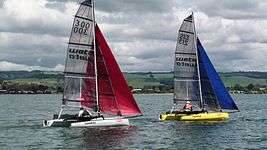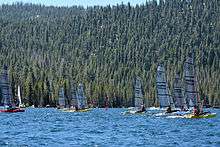Weta Trimaran
The Weta 4.4 Trimaran is a 4.4 metre (14 foot) sailing dinghy conceived and developed in New Zealand from 2001-2006 by Roger and Chris Kitchen and others with original drawings by TC Design's Tim Clissold.
Class symbol | |
 Weta racing in the High Sierra Regatta | |
| Development | |
|---|---|
| Designer | Roger and Chris Kitchen, Tim Clissold |
| Location | Auckland, New Zealand |
| Year | 2006 |
| Design | One-design |
| Boat | |
| Crew | 1-3 adults / max 240 kg (530 lb) |
| Hull | |
| Type | Open trimaran |
| Construction | Carbon fiber, fiberglass and foam |
| Hull weight | Approx. 120 kg (260 lb) (fully rigged) |
| LOA | 4.4 m (14 ft) |
| Beam | 3.5 m (11 ft) (rigged) 1.7 m (5.6 ft) (on trailer) |
| Hull appendages | |
| Keel/board type | Daggerboard |
| Rig | |
| Rig type | Fractional Bermuda or Marconi rig with gennaker |
| Mast length | 5.6 m (18 ft) |
| Sails | |
| Mainsail area | 9.3 m2 (100 sq ft) [1] (Sq. Top) |
| Jib/genoa area | 3.2 m2 (34 sq ft) |
| Spinnaker area | 8 m2 (86 sq ft) |
| Upwind sail area | 20.5 m2 (221 sq ft) (Square Top) |
| Racing | |
| D-PN | 78.5 |
| RYA PN | 950 |




Design
The boat is constructed from fibreglass and carbon fibre, and is popular as a racing boat or for recreational sailing.[2] It has added stability and righting moment from the trimaran amas or floats.
Recognition
The Weta Trimaran is recognized as one design class by Yachting New Zealand,[3] the French Sailing Federation,[4] and the Royal Yachting Association in the UK.[5] It has been approved for the Paralympics [6] and World Masters Games [7].
Awards
In 2010 the Weta Trimaran was awarded Boat of the Year by Sailing World magazine.[8]
Builds
There are two distinct builds of the Weta Trimaran, the 'original build' and the '2015 Weta' which was created from a new mold and included (mostly internal) hull revisions. In April 2017, Weta announced the availability of a foam-core Weta which as well as being stiffer is right on the minimum weight of 120Kg in the class rules.
Original build
Early prototypes were produced in New Zealand but from 2006 to 2014 the 'original build' was manufactured in China for Weta Marine and sailed internationally[9] with 1200+ boats sold to date with the largest fleets in France and the USA.[10][11] Its sails were manufactured by Dutch windsurfing sail-maker Gaastra.
The design evolved over time:
- Color changes (Most boats were produced to four RAL color codes: Red (3020), Yellow (1018), Green (6018), Light Grey (7035). Some very early boats featured alternative red and yellow hues)
- Three rudders
- New deeper daggerboard
- Mylar sails
- Minor modifications to forestay tack fitting
- Optional furling jib
- Optional mainsails:
- Small training mainsail
- Heavy weather mainsail
- 'Resort' mainsail (Dacron)
2015 Weta
In 2014 the new 2015 Weta was announced.
Structural and cosmetic improvements include:
- Deck (screecher furler cleat on cockpit side, swaged stays, Liros ropes and optional hiking strap, enhanced grip, new raised foredeck detail for enhanced strength and durability)
- Floats (Change to seamless construction and removal of rear lip. Switch to Nairn hatches.)
- Sails (Switch of manufacturer to North Sails)
- Centrecase (precision fit via nylon pile)
- Trampoline (improved alignment via custom carbon pads)
- Rudder bar and gudgeons (strength and durability enhancement)
In September 2014 the first of the new '2015 Weta' build were shipped to customers in the US.
2017 Foam Core Weta & Square Top Sail
In April 2017, Weta announced the availability of a foam-core hull (right on the class weight limit of 120Kg) and bi-radial cut 9.3 m square top mainsail (compared to the original Pin-head 8.3 m mainsail. Nearly all Wetas built since 2018 have been foam core and the Square Top sail has been adopted as the standard sail for racing in most regions.
2020 Self-tacking jib kit
In February 2020[13], Weta announced the availability of a Self-Tacking Jib kit designed to be retrofitted to existing hulls or as an addition to new boats. The kit allows taking without adjusting the jib sheets and includes a slightly smaller jib which is 3.0sqm. Around 6% less sail area than the standard jib at 3.2sqm.
Performance
- Top recorded Speed: 20.68 kn (38.30 km/h; 23.80 mph) by Tom Kirkman, USA.
- Rigging time: 20 minutes
See also
References
- Weta dealer update April 2017
- "Sailing World". Weta Trimaran Best Dinghy. Sailing World. Retrieved 2011-06-30.
- "Yachting New Zealand". Directory of All Class Associations. Retrieved 2011-06-30.
- "Federation Francaise de Voile". Les Associations de Classe. Retrieved 2012-11-22.
- List of boats with RYA Portsmouth Numbers#cite note-RYA2013-1
- https://hansasailing.com/2016/11/13/hansa-303-named-one-new-para-world-sailing-classes/
- Auckland 2017 - https://www.sail-world.com/Australia/Weta-to-be-part-of-the-World-Masters-Games/
- "Small Trimarans". How to Set Up a Weta Trimaran in 15 Minutes. Retrieved 2011-06-30.
- Link text, Access date 30/06/2001.
- http://wetamarine.com/about/news/705-weta-celebrates-1000-boats
- http://www.wetamarine.com/owners/weta-world-map
- "British Weta Class Association: The Boat - Development".
- "New Self Tacking Jib - A Game Changer!". Weta Marine.
- "BoatDesign.net". Weta Trimaran-sailing worlds best dingy. Retrieved 2011-06-30.
External links
- Weta Marine
- TC Design
- Weta classe France
- British Weta Class Association
- Australian Weta Class
- Weta Class of North America
- Weta Forum, Buyers Guide and Weta Wiki - everything you need to know in one place


- Video of the High Sierra Regatta Race 1 Weta Tri, "Mary Ann", Fresno Yacht Club's "High Sierra Regatta", July 2013.
- to celebrate the 1000th boat sold